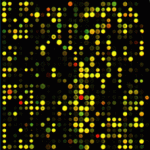Genomics
|
2 december 2019 21:03:01 |
| Absolute nucleosome occupancy map for the Saccharomyces cerevisiae genome [METHOD] (Genome Research) |
|
Tweet Mapping of nucleosomes, the basic DNA packaging unit in eukaryotes, is fundamental for understanding genome regulation because nucleosomes modulate DNA access by their positioning along the genome. A cell-population nucleosome map requires two observables: nucleosome positions along the DNA (`Where?`) and nucleosome occupancies across the population (`In how many cells?`). All available genome-wide nucleosome mapping techniques are yield methods because they score either nucleosomal (e.g., MNase-seq, chemical cleavage-seq) or nonnucleosomal (e.g., ATAC-seq) DNA but lose track of the total DNA population for each genomic region. Therefore, they only provide nucleosome positions and maybe compare relative occupancies between positions, but cannot measure absolute nucleosome occupancy, which is the fraction of all DNA molecules occupied at a given position and time by a nucleosome. Here, we established two orthogonal and thereby cross-validating approaches to measure absolute nucleosome occupancy across the Saccharomyces cerevisiae genome via restriction enzymes and DNA methyltransferases. The resulting high-resolution (9-bp) map shows uniform absolute occupancies. Most nucleosome positions are occupied in most cells: 97% of all nucleosomes called by chemical cleavage-seq have a mean absolute occupancy of 90 ± 6% (±SD). Depending on nucleosome position calling procedures, there are 57,000 to 60,000 nucleosomes per yeast cell. The few low absolute occupancy nucleosomes do not correlate with highly transcribed gene bodies, but correlate with increased presence of the nucleosome-evicting chromatin structure remodeling (RSC) complex, and are enriched upstream of highly transcribed or regulated genes. Our work provides a quantitative method and reference frame in absolute terms for future chromatin studies. |
| 333 viewsCategory: Bioinformatics, Genetics, Genomics |
 Accessibility of promoter DNA is not the primary determinant of chromatin-mediated gene regulation [RESEARCH] (Genome Research) Accessibility of promoter DNA is not the primary determinant of chromatin-mediated gene regulation [RESEARCH] (Genome Research)Modeling Niemann-Pick disease type C in a human haploid cell line allows for patient variant characterization and clinical interpretation [METHOD] (Genome Research) 
|
| blog comments powered by Disqus |
MyJournals.org
The latest issues of all your favorite science journals on one page
The latest issues of all your favorite science journals on one page



